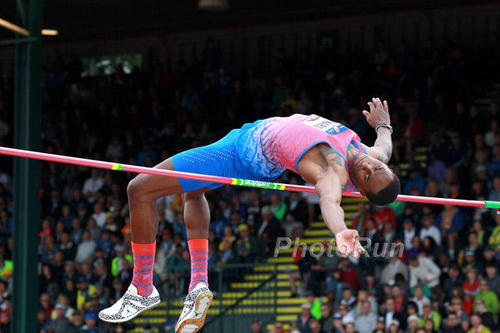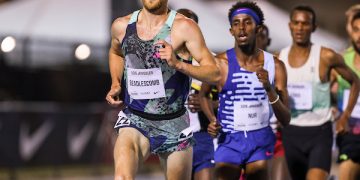Erik Kynard is a really nice guy. I met him in the Eugene airport and we had a quick chat as we both tried to fix airline flights. But, on the high jump apron, he is a tough chess player. The high jump, for those who watch it, love it, revel in it, is an athletic game of chess. And Erik Kynard is one of the finest jumpers in the world.
In this fine peice by David Hunter, we get a quick look into what motivate Erik Kynard. Kynard is sponsored by Brand Jordan, I remind you. There are but a few non basketball players who have such a sponsorship deal. But, what is most remarkable about Erik Kynard is his focus, his fighting spirit and his keen observation of his art.
Watch this fine athlete in Rio de Janiero. He is meant for great things.
 Erik Kynard, photo by PhotoRun.net
Erik Kynard, photo by PhotoRun.net
Erik Kynard: Ready For Rio’s Big Chess Match
August 1st, 2016
Eric Kynard – two-time Olympian and reigning Games silver medalist in the men’s high jump – never attempted the high jump until he was in the 8th grade. It was an awkward baptism. “It wasn’t necessarily natural. Jumping is natural, but high jumping is not natural. It was definitely not natural for me,” the Toledo, Ohio native confesses. Decades after Dick Fosbury’s back-bending approach revolutionized the event, Kynard’s early tutelage remained primitive. “I started out with the Western Roll. I went like 5’3″ or something like that,” he laughs.
But soon things started to change. First, Kynard made a clumsy technique transition from a roll to a modified flop. “I eventually started to jump, twist, and just sit in the air – I was afraid to go over backwards. I didn’t necessarily flop as far as technique was concerned until I was a freshman.” Seeking a mentor, the young jumper switched schools. “I transferred to Toledo Rogers to get a really good high jump coach. It didn’t take long at all,” smiles Kynard.
“Everything started to happen pretty fast,” he explains. Two years after his first bumbling Western Roll effort, Erik Kynard was clearing 7 feet as a high school sophomore. High jump’s ugly duckling was becoming its swan. “It didn’t take long at all to start getting letters of interest and contacts from schools. But my breakout year was really my junior year. After being with coach Eric Browning for a year and under his tutelage, I think I cleared 7 feet or higher every meet my junior year.”
“I actually competed in the Trials in ’08. I was a high school guy, a rising senior. I just got interested in a lot of colleges and different programs there. I was just kind of hacking around asking where I should go to school. And everybody said, ‘K-State They’re serious about high jumping. Cliff Rovelto is the best coach for the event.'”
Kansas State proved to be a good choice for Kynard. With Rovelto building on the progression ignited by Browning, Kynard flourished in Manhattan, Kansas. The young Wildcat athlete captured 2 NCAA outdoor high jump championships and went on to win several USATF national high jump titles as well. An Olympic high jumper while still in college, Kynard won the silver medal at the London Games with a clearance of 2.33m/7’7¾”. And the still youthful jumper has had a top-ten world ranking every year since 2011.
Undeniably talented, Erik Kynard brings a solid work ethic to his craft. And the passionate 25-year old Kynard also combines a certain showmanship with his competitive efforts. And he likes to see the sport taking chances and exploring different ways to package and deliver its product in the 21st century. “I think it’s good that they’re finally trying to reevaluate how they do things,” states the jumper as he looks back on how the world championships in Beijing and Portland blended music, varied lighting, fog machines, and off-premises medal festivals with the simplicity and grandeur of the world’s oldest sport. “The thing about track & field that is most interesting is that it is historic. It’s one of the oldest athletic events,” offers Kynard. “But that’s also its Achilles heel – the sport is old and people can be very arrogant and closed-minded when it comes to this sporting event. It’s the only sporting event that hasn’t changed – zero drastic changes. They essentially want to the same things over and over again and just expect a different outcome. And you can’t do it that way,” he bemoans. But Kynard – who once perched a Burger King crown on his head after winning an NCAA high jump championship – is encouraged by some of the innovation in track & field presentation he and others have observed. “People now are being a little more innovative and people who care about the sport – especially here in the States – are using that platform at indoor Worlds and changing the format and doing things of that nature,” declares Kynard. “I think it’s great.”
Kynard’s progression through this Olympic year has been encouraging and suggests he is building toward what he hopes will be a crescendo in Rio. After capturing the high jump bronze at the World Indoor Championships in Portland in March, Kynard – who has an outdoor PR of 2.37m/7’9¼” and has cleared 2.34m/7’8″ indoors – has used the Diamond League gatherings as stepping stones to the Olympics as he has squared off against the world’s best in various world capitals. As the DL takes a mid-summer Olympic hiatus, Kynard – with a win and two seconds – is currently in second place in the overall standings with 22 points, trailing Ukraine’s Bohdan Bondarenko by only 4 points. “And I missed two meets,” exclaims Kynard who notes the balancing act between the pursuit for the Diamond League trophy and the quest for Olympic gold. “Basically, that’s really the sacrifice I made. If you miss the meets, you’re not getting any points and everybody else is catching up,” explains Kynard on his decision to bypass two DL contests as he notes the choice athletes must make. “I could have just chased the win in the Diamond League. You can try to win the Diamond League or you can try to win a gold medal. So you kind of have to pick what you want your focus to be.” With 4 Diamond League gatherings remaining and double points awarded in the final two contests in Zürich and Brussels, Kynard knows he is well positioned to battle for the DL crown. “I’m looking forward to it,” he adds with a smile.
With the Olympic Games in sight, a survey of the high jump field suggests that Kynard has every reason to believe he’ll be in the medal hunt. First of all, two tremendous jumpers – considered formidable competitors only months ago – are out. Russia’s Ivan Ukhov – the defending Olympic champion – has been sidelined by the suspension of the Russian track & field squad. And Gianmarco Tamberi – who copped the indoor world championship crown with a dramatic come-from-behind first-attempt clearance at 2.36m/7’8¾” – was eliminated when a severe ankle injury to his plant foot forced the half-bearded Italian to conclude his season and mournfully declare, “Goodbye, my Rio!!” But Kynard – currently ranked #7 on the world list with a season best clearance of 2.35m/7’8½” – knows that fierce competitors still remain for the Olympic high jump showdown: Qatar’s Mutaz Barshim has the world leader at 2.40m/7’10½”. Reigning world champion Derek Drouin – who took bronze in the London Games – is WL#3 at 2.38m/7’9¾”. And always-dangerous Ukrainian jumper Bohdan Bondarenko is WL#4 at 2.37m/7’9¼”.
As Kynard prepares to head to Brazil, he plans to taper and clean up a few little execution details in his jump. “You essentially approach every championship competition kind of the same. Right now, I am still lifting pretty heavy,” he outlines. “The thing you curtail the most is the lifting and the running,” explains Kynard on shortening his sprints and lightening his lifting. “The lifting is more dynamic and explosive. The goal is to maintain strength and focus on technique, mechanical stuff. That’s basically where the tapering takes place – the focus on technique and remaining explosive and mechanically correct.”
Unlike 2015 when he believes he lacked the best mental outlook, Kynard – whose high jump victory at the Olympic Trials represented his 4th consecutive outdoor national high jump championship – now finds all the stars and planets properly aligned for what he hopes will be a breakthrough performance at the Games. “Last year, I thought I was ready physically. But I don’t think I was ready mentally. I think I was just a little frustrated,” admits Kynard. “But this year I definitely put myself in a more progressive state as far as a mental approach to the event. I think I’m ready to go. There is no doubt now.”
Injury free, Kynard declares he is in great shape for Rio. “Physically, I’m fantastic. I pulled out of one meet. After the Trials – after jumping twice in the rain – I just felt like my body was just kind of like ‘OK, let’s just slow it down a little bit.’ I didn’t want to push it too hard. So I pulled out of Monaco. And people were jumping exceptionally at Monaco. I just opted to train,” offers Kynard as he explains the careful balance between training and competing. “It is difficult when you are a professional athlete because when you are competing, you’re not training. So in competition – while you’re competing at these Diamond League meets and other competitions – no training is taking place. So you have to give yourself days before the competition to prepare and days after the competition to recover. So I just decided that for me and what I wanted to do, I would rather focus on training a little bit rather than going to compete.”
Erik Kynard – who has medaled twice in global competitions – knows the type of competitive athlete he is and what he needs to do to perform at his highest level in Rio. “For me, I’m a very excitable guy when I compete – very passionate. And for me, I have to put myself in a place of peace and just mentally be prepared for anything,” states the former Kansas State star. “You can’t control all the variables. Anybody who tries to play scenarios in their head and do this and that, you may end up blowing it for yourself. So you definitely have to just go out there and look to compete at a high level. And that should be your focus. Because you can’t control another guy. I can’t control how hot this guy’s going to be this day. I can’t bother and attempt to be better than someone else. I have to just go out and be the best ‘me.'”
But unlike the throws and the horizontal jumps where it is all about execution and strategy is essentially irrelevant, the vertical jumps [the high jump and the pole vault] require energy conservation and jump count management so that an athlete can reach down late in the competition and summon the extra energy to execute that magnificent winning clearance. And tactics play a role the high jump’s end game – like when your sole remaining competitor makes a first round clearance while you miss. Do you work to clear that bar? Or do you pass to the next height with only two attempts remaining? “If it’s just you and one other competitor, you automatically pass, because you never want to put yourself in a position where you’re jumping and you’re still going to be in second whether you make or miss the bar,” explains Kynard, citing the importance of constraining your jump count – and your energy. “There’s no reason to jump at a height if it’s not going to put you in first.”
Erik Kynard will admit that there is a cerebral element to the high jump. But he’s also a guy who likes to avoid unnecessary complication, Erik tries not to overthink the event. “There are tactics involved, but at the end of the day the goal is to jump higher than the other person,” explains Kynard in the simplest of terms. “It’s not necessarily like politics. It’s more like chess,” he adds. “Yeah, you have to be strategic, but at the end of the day, you’re trying to get the other guy’s king.”
Author

Dave Hunter is an award-winning journalist who is a U.S. Correspondent for Track & Field News. He also writes a weekly column and serves as Senior Writer for www.RunBlogRun.com, and covers championship track & field competition domestically and in such global capitals as Moscow, Birmingham, Zurich, Brussels, Beijing, Rio de Janeiro, Zagreb, Ostrava, and Doha. Hunter frequently serves as the arena or stadium announcer for championship track & field gatherings, including the Ivy League, the Big East, the Mid-American Conference, the NAIA, the Big Ten, and the Millrose Games. Hunter has undertaken foreign and domestic broadcast assignments. He ran his marathon P.R. 2:31:40 on the Boston Marathon course back in the Paleozoic Era. To find out more about Dave, visit his website: www.trackandfieldhunter.com He can be reached at: dave@trackandfieldhunter.com
View all posts




















